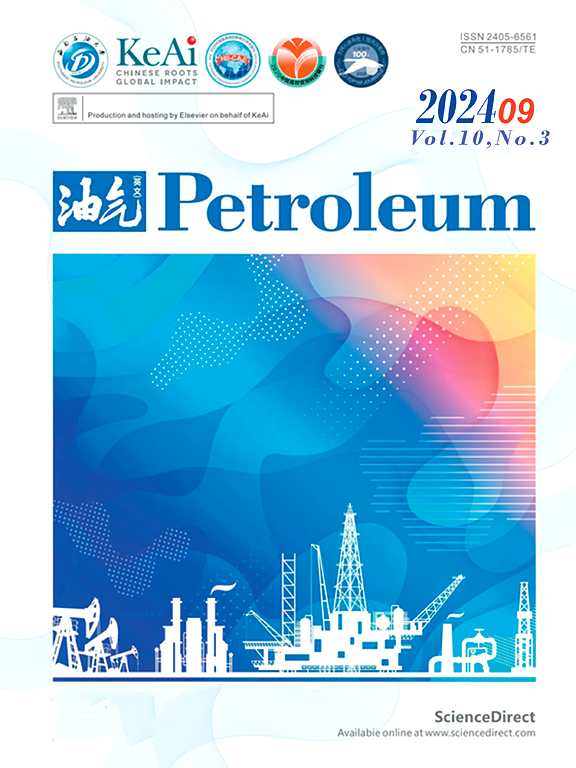Active control of the fluid pulse based on the FxLMS
IF 4.2
Q2 ENERGY & FUELS
引用次数: 0
Abstract
In petroleum engineering, the performance of drilling fluid is the key factor affecting the drilling success. Drilling fluid rheology can be measured by tube measurement. Fluid pulsation will cause measurement deviation of differential pressure and flow velocity data during measurement, and it accumulates when the flow curve is drawn. Finally, the accuracy of drilling fluid rheological pipe measurement is seriously affected. In view of the problem of fluid pulsation can seriously affect the accuracy of tube measurement. This paper proposed an algorithm based on Filtered-x least mean square (FxLMS). First, the active control strategy is studied, the mathematical model of electric regulating valve control is established, the FxLMS algorithm of variable step length is studied, the simulation model of the control system is established, and the control effect of different algorithms is compared. The dynamic experimental platform of fluid pulse active control for drilling fluid rheological pipe measurement is designed and built. The experimental data show that: after active control, the average relative error of drilling fluid shear force decreased by 179.6%, the average relative error of plastic viscosity decreased by 78.1%, and the average relative error of the apparent viscosity decreased by 25.5%. It proves that the active control algorithm can improve the accuracy of tube measurement more effectively.
基于FxLMS的流体脉冲主动控制
在石油工程中,钻井液性能是影响钻井成功的关键因素。钻井液流变性可以通过管式测量来测量。在测量过程中,流体脉动会引起压差和流速数据的测量偏差,并在绘制流量曲线时累积。最后,严重影响了钻井液流变管测量的精度。鉴于流体脉动问题会严重影响管道测量的精度。提出了一种基于滤波-x最小均方(filter -x least mean square, FxLMS)的算法。首先,研究了主动控制策略,建立了电动调节阀控制的数学模型,研究了变步长FxLMS算法,建立了控制系统的仿真模型,比较了不同算法的控制效果。设计并搭建了用于钻井液流变管测量的流体脉冲主动控制动态实验平台。实验数据表明:主动控制后,钻井液剪切力的平均相对误差减小了179.6%,塑性粘度的平均相对误差减小了78.1%,表观粘度的平均相对误差减小了25.5%。实践证明,主动控制算法能更有效地提高管材测量精度。
本文章由计算机程序翻译,如有差异,请以英文原文为准。
求助全文
约1分钟内获得全文
求助全文
来源期刊

Petroleum
Earth and Planetary Sciences-Geology
CiteScore
9.20
自引率
0.00%
发文量
76
审稿时长
124 days
期刊介绍:
Examples of appropriate topical areas that will be considered include the following: 1.comprehensive research on oil and gas reservoir (reservoir geology): -geological basis of oil and gas reservoirs -reservoir geochemistry -reservoir formation mechanism -reservoir identification methods and techniques 2.kinetics of oil and gas basins and analyses of potential oil and gas resources: -fine description factors of hydrocarbon accumulation -mechanism analysis on recovery and dynamic accumulation process -relationship between accumulation factors and the accumulation process -analysis of oil and gas potential resource 3.theories and methods for complex reservoir geophysical prospecting: -geophysical basis of deep geologic structures and background of hydrocarbon occurrence -geophysical prediction of deep and complex reservoirs -physical test analyses and numerical simulations of reservoir rocks -anisotropic medium seismic imaging theory and new technology for multiwave seismic exploration -o theories and methods for reservoir fluid geophysical identification and prediction 4.theories, methods, technology, and design for complex reservoir development: -reservoir percolation theory and application technology -field development theories and methods -theory and technology for enhancing recovery efficiency 5.working liquid for oil and gas wells and reservoir protection technology: -working chemicals and mechanics for oil and gas wells -reservoir protection technology 6.new techniques and technologies for oil and gas drilling and production: -under-balanced drilling/gas drilling -special-track well drilling -cementing and completion of oil and gas wells -engineering safety applications for oil and gas wells -new technology of fracture acidizing
 求助内容:
求助内容: 应助结果提醒方式:
应助结果提醒方式:


